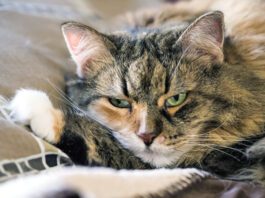When Acrobatic Prowess Fails Them
When it comes to leaping, landing and twisting in mid-air, cats earn accolades for agility, flexibility and acrobatic prowess. Its not unusual to witness your cat leap effortlessly to the top of the refrigerator and, when ready, to land softly and easily on the kitchen floor. But despite their grace and flexible physique, cats do not always land safely on their feet and can be at risk for painful sprains, broken legs, and other fractured bones.
A Warning on Human Skin Cancer Cream
The Food and Drug Administration is warning owners, veterinarians, healthcare providers and pharmacists of the risk of pets illness and death associated with the topical human cancer medication fluorouracil. Initial reports cited the death of five dogs who accidentally ingested the prescription cream, which is also sold as Carac, Efudex and Fluoroplex. While the FDA has yet to receive reports involving cats, the agency expects cats to be extremely sensitive to the cream, which is used to treat pre-cancerous and cancerous skin growths.
Short Takes: March 2017
Scientists have identified many factors that affect a species survival - from diet and weather to the size of breeding groups to social relationships. However, researchers at Michigan State have found that some wild cats dont necessarily respond to the same evolutionary pressures as other mammals, including humans and primates.
Batman the Four-Eared Cat Finds Fame and New Home
A black cat with four ears named Batman made national news only hours after being made available for adoption at the Western Pennsylvania Humane Society in Pittsburgh. Just when you think youve seen it all, a four-eared cat comes in the door! says Hala Nuemah, shelter managing director.
Cat Whiskers; Feline Heart Health
If youve ever been tempted to trim your cats whiskers, it would be best to resist the impulse. Whiskers are essential to cats navigation. They also serve as early warning systems and barometers of mood, says Leonie Richards, BVSC, head of general practice at the University of Melbourne Veterinary Hospital. The Winn Feline Foundation has awarded a grant to research at-home use of Holter monitoring in cats with hypertrophic cardiomyopathy (HCM).
20 Inspirational Ideas for Cat Owners
At the close of each year, do you find yourself writing a list of ambitious resolutions to eat healthier and exercise more? Perhaps you decide to eat more kale and spend more time at yoga and less lounging on the couch. We often craft New Years resolutions with good intentions but rarely fully achieve them.
A Promising Drug for Feline Herpes Virus
Eye problems occur frequently in cats with feline herpes virus 1 (FHV-1) and can lead to blindness if untreated. Current medications must be applied several times daily and evidence of their effectiveness is lacking.
A New Era in Medicine: Feline Genetic Screening
Complete genomes - genetic blueprints - of numerous cats DNA have been sequenced in what has been described as a new era in veterinary medicine. Cornells Veterinary Biobank, as one example, is a database of DNA and tissue samples from several species. The biobank is supported in part by the Cornell Feline Health Center.
A New Report Says Healthy Aging Can Be Achievable
Its now generally accepted that feline healthy aging is achievable just as it is in humans where the field of aging is dedicated to optimizing mental, social and physical well-being and function in older adults, the report says. What has been less well defined, however, is what healthy aging actually looks like in a cat; in other words, what changes would be considered normal for age … as opposed to deteriorative changes.
Treating Infectious Peritonitis; Cornell Study on Anesthesia
Feline infectious peritonitis, or FIP, a viral disease that is nearly 100 percent fatal, has been successfully treated in a research project at Kansas State University. Collaborators in diverse fields developed an antiviral compound for the feline coronavirus associated with FIP. Manuel Martin-Flores, MV, , ACVAA, of the Cornell University College of Veterinary Medicine will present preliminary results of his research on safer anesthesia for cats at the annual meeting of the American College of Veterinary Anesthesia and Analgesia in September. Dr. Martin-Flores is one of only 220 anesthesiologists board-certified worldwide by the college.
An Exciting New Frontier in Medicine
Your arthritic cat walks stiffly, and its difficult to find a medication to treat him without side effects. Could stem cell therapy be an option? Its use in human medicine has grown in the past decade, heralded as a promising treatment for a host of diseases. The latest area of pioneering research, according to the National Institutes of Health, is adult-derived stem cells for repair of the heart.
Your Cat Can Help Genetic Research
Diseases such as inflammatory bowel disease, hypertrophic cardiomyopathy and diabetes mellitus may have a genetic basis, and by comparing DNA from affected and healthy cats, the Biobank hopes to locate the responsible genes. Its work could lead to identifying cats at risk of disease and aid in developing more effective treatments.














